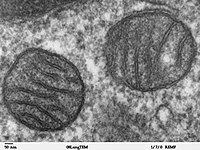
Photo from wikipedia
Τhe natural history of type 2 diabetes mellitus is characterized by a progressive loss of pancreatic beta cell function and insulin resistance. Bisphenol A (BPA) is an endocrine‐disrupting chemical that… Click to show full abstract
Τhe natural history of type 2 diabetes mellitus is characterized by a progressive loss of pancreatic beta cell function and insulin resistance. Bisphenol A (BPA) is an endocrine‐disrupting chemical that is used widely in industry; people are exposed to BPA and its products daily. Studies have delineated that BPA alters the function of pancreatic beta cells. Herein, we examined the effect of low doses of BPA on pancreatic beta cell viability and apoptosis and we tried to elucidate the mechanisms involved in these processes. Beta‐TC‐6 (ATCC® CRL‐11506™) cells were cultured with a medium containing the following dilutions of BPA: 0.002, 0.02, 0.1, 0.2, 2 μΜ up to 72 h. We examined the viability and adenosine triphosphate (ATP) levels of cells. Then, we measured apoptosis, cell cycle, and insulin levels. We quantified the levels of proteins implicated in the mitochondrial pathway of apoptosis; and finally, we quantified the intracellular reactive oxygen species and mitochondrial superoxide. We found that the exposure of Beta‐TC‐6 cells to BPA results in a decrease in cell viability, ATP levels, and an increase in insulin levels. We found an increase in apoptosis levels and a decrease in cell cycle levels. In addition, we provide evidence of the levels of apoptotic proteins. Finally, we found an increase in the cellular reactive oxygen species and mitochondrial superoxide production. Exposure to low concentrations of BPA triggers the mitochondrial pathway of apoptosis via the generation of intracellular reactive oxygen species and mitochondrial superoxide on Beta‐TC‐6 cells in a dose‐dependent way.
Journal Title: Journal of Biochemical and Molecular Toxicology
Year Published: 2022
Link to full text (if available)
Share on Social Media: Sign Up to like & get
recommendations!